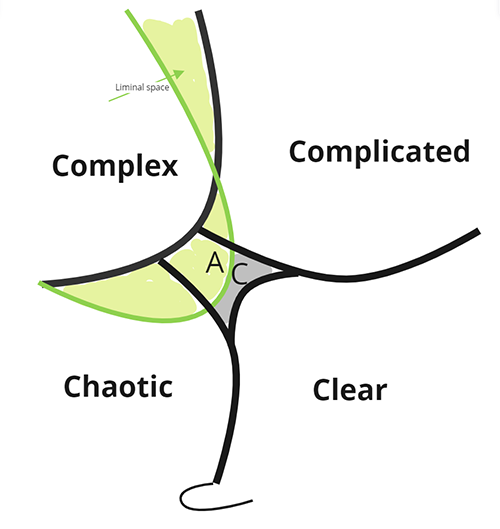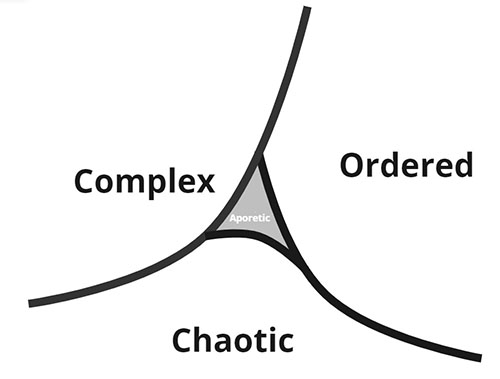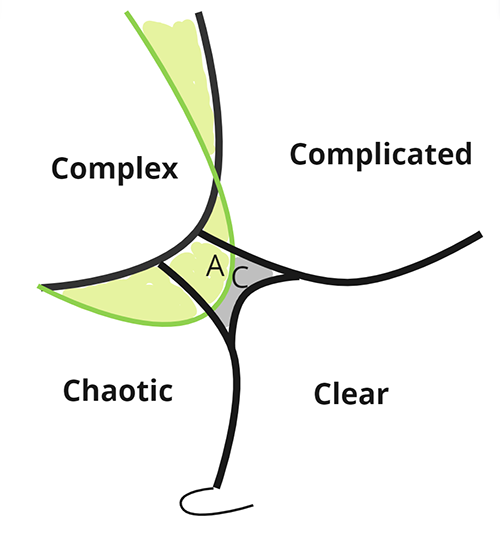Cynefin is a decision-support framework to help understand which type of response to a situation is most effective.

Created by Dave Snowden in 1999, Cynefin (pronunciation kuh-NEV-in) is Welsh for “place of your multiple belongings.” Born as a “back of a napkin drawing,” it has evolved into a tool that enables people to make well-informed decisions on how to best solve a specific problem.
Cynefin helps us to understand when it makes sense to thoroughly analyze and create detailed plans and when it is better to run multiple small probes, assess the situation, and then decide what to do next. It also helps you understand when you best can act first or when you can work with standard solutions.
In the mid-nineties, Dave Snowden grew to dislike following standard approaches to address issues. Triggered by developments and publications around that time, he started focusing on finding a way to consider different contexts to determine the best approach. As an interesting aside, software professionals had similar insights around the same time, which led them to create lightweight approaches like scrum and XP — ultimately bringing us the Agile Manifesto.
In 1999, Snowden created the first version of Cynefin. Ever since that day, it has evolved. However, two aspects have always been a part of Cynefin:
The current Cynefin framework looks very different from the earliest versions. On top of that, the framework has different official depictions. This is a result of Snowden’s attempts to clarify without losing sight of the essentials.
The most commonly used depiction of the Cynefin framework recognizes five domains:
Here is a graphical depiction of Cynefin:

Each domain has different characteristics and recommended responses. It is crucial to understand which domain your topic resides in. Once this is clear, Cynefin enables you to have an effective response leading to the desired results.
The clear domain involves best practices. There is one best way to act and no freedom to do it differently.
The steps in the clear domain are sense, categorize, and respond.
You start with understanding the issue at hand. Next, you place the issue into a specific category. This will bring you the correct response.
Think of an order taker at a McDonald’s restaurant. They know and follow the exact instructions to serve a client their requested Big Mac without tomatoes. All administrative and meal preparation steps are categorized. There’s no option to deviate from this.
Throughout the years, the clear domain had different names like “known,” “simple,” and “obvious.”
In the complicated domain, the relation between cause and effect is not immediately apparent. Expertise and analysis bring the best answer to a problem.
The steps in the complicated domain are sense, analyze, and respond.
As with the clear domain, you start with sensing the facts. Next, expert analysis brings a good answer that is then applied.
Traditional projects, like in construction, mostly reside in the complicated domain. To build a skyscraper, extensive analysis of all kinds of impacting criteria is needed to create a design and a plan of approach. Multiple good options may surface, but one is chosen and executed.
In the early days of Cynefin, the complicated domain used to be called “knowable.”
Dave Snowden often puts clear and complicated together, calling it the ordered domain. Indeed, variations of Cynefin exist that have only three domains — chaotic, complex, and ordered.
The complex domain is about verifying assumptions. Cause and effect can’t be determined upfront, but only after the fact. This is why thorough analysis is a wasteful activity.
The steps in a Complex domain are probe, sense, and respond.
In a complex domain, you may know what you wish to achieve, but you don’t know how to achieve it. You run multiple small probes to sense which is most successful. Once this is established, you can decide to proceed with the most successful idea.
To clarify this, let us assume we are responsible for a social media app. We wish to increase the engagement of the users but don’t know which idea would be most effective. We can roll out the different functionalities to small subsets of the entire user base and measure the impact of each of them. Then, we can learn from the information and then decide to roll out the most successful one to all users.
Agile approaches like scrum exist to work in the complex domain. Scrum uses empiricism (transparency, inspection, and adaptation). This effectively is Cynefin’s probe, sense, and respond.
The chaotic domain calls for action. There’s no clear link between cause and effect. It is useless to analyze, categorize, or to probe.
The steps in a chaotic domain are act, sense, and respond.
You start with taking action. The action is typically to move the problem to another domain. Then you sense the impact of the action and determine the next steps.
A typical example of chaos and the chaotic domain is when a building is on fire. You will immediately move to a place where you are safe and then assess the situation to understand what will be the best next course of action. An example of deliberate chaos could be putting two strangers in a room without warning to force an action. Any action.
Chaotics is the domain of innovation, where new ideas emerge.
For the longest time, Cynefin has had a section called confusion. Confusion happens when there is no clarity about which domain fits the situation. Often, this can be resolved by breaking the topic into parts that fit into one of the other domains.
In earlier versions of Cynefin, it was called disorder. But this term was considered to be too passive. Also, the idea of having five names starting with “C” was more appealing.
As a more recent development, David Snowden decided to add the term “aporia.” This Greek word means something in the order of “embracing contradictions.” The fact that this is an active stance appealed to Snowden.
Below is the Cynefin framework with the clear and complicated domains replaced by ordered, and with the middle part called aporetic. Snowden advises using this as the Cynefin entry point.
“Ordered” where the outcome is certain, as opposed to two distinctly different domains of complex and chaotic. Ordered is solid, complex is liquid, and chaotic is gas. When this is established, ordered can be divided into clear and complicated:

Many view the Cynefin framework as a static model. They use it to determine in which their problem resides to find out which approach may be their best fit. But Cynefin underlines that what is true today may not be true a month from now. People may gain additional knowledge or the environment of the problem may have changed. Also, one of the aspects of the chaotic domain is aiming to get out of it.
Examples of Cynefin dynamics involving knowledge flows are:
A discussion about Cynefin is not complete without mentioning liminality. These are four spaces, depicted in green below.
Typically these spaces provide more context and are therefore safer. An example in a complex/complicated space would be when there is doubt about which of many options would be the best to go for. Once this is clarified through doing parallel probes, the rollout of the option resides in the complicated domain:

Product managers aim to maximize the value of their products. For many, this involves working with many different teams and departments. All of them are responsible for a piece of the product experience. But all have their own context. This is where Cynefin helps.
For starters, Cynefin clarifies that it is unlikely everyone will be effective using the same approach, like scrum or PRINCE2. Instead, we should embrace the fact that different aspects of the product experience may reside in different Cynefin domains.
Some parts may be complex, like when you don’t know which of your ideas to engage your users is most effective. Other parts may be complicated, like trying to resolve a recurring incident. In the same vein, you may also have clear, chaotic, or confusing topics.
Cynefin helps to realize this and as a result how to respond in specific contexts. But Cynefin doesn’t answer questions like:
Cynefin is a sensemaking framework only. For answers to questions like the above, product managers need to look further. I would personally recommend having your discussions, measurements, and assessments of progress on what you wish to achieve. After all, what matters most is that actions from people and teams help create value. Product managers can do this by creating outcome-based objectives and ensuring this is what makes the teams tick.
Cynefin is a decision support framework to help understand the nature of your problem domain and make guided decisions. Since its inception, it has gone through many lifecycles. Regardless, it has become very popular in many areas.
The five Cynefin domains are clear, complicated, complex, chaotic, and confusion. Every domain has its unique characteristics and recommended responses. Cynefin serves to help understand the nature of their problem space and then understand how to best address it.
Furthermore, Cynefin gives insights into knowledge flows. For example, when the insights from probing different options will move a topic from complex to (eventually) complicated.
Products typically have attributes in multiple domains. These attributes all call for different responses. Cynefin is ideally suited to help product managers gain these insights.
Featured image source: IconScout

LogRocket identifies friction points in the user experience so you can make informed decisions about product and design changes that must happen to hit your goals.
With LogRocket, you can understand the scope of the issues affecting your product and prioritize the changes that need to be made. LogRocket simplifies workflows by allowing Engineering, Product, UX, and Design teams to work from the same data as you, eliminating any confusion about what needs to be done.
Get your teams on the same page — try LogRocket today.

A practical framework for PMs to use AI in ideation without sacrificing judgment, strategy, or decision quality.

A practical five minute revenue estimation method to help product managers compare ideas, drop low impact features, and prioritize smarter.

A practical guide for PMs who want to stop being bottlenecks, delegate smarter, and lead teams effectively with a clear ownership framework.

Stop letting unreliable data block features. Treat data as inventory to track quality, ownership, and ship with confidence.